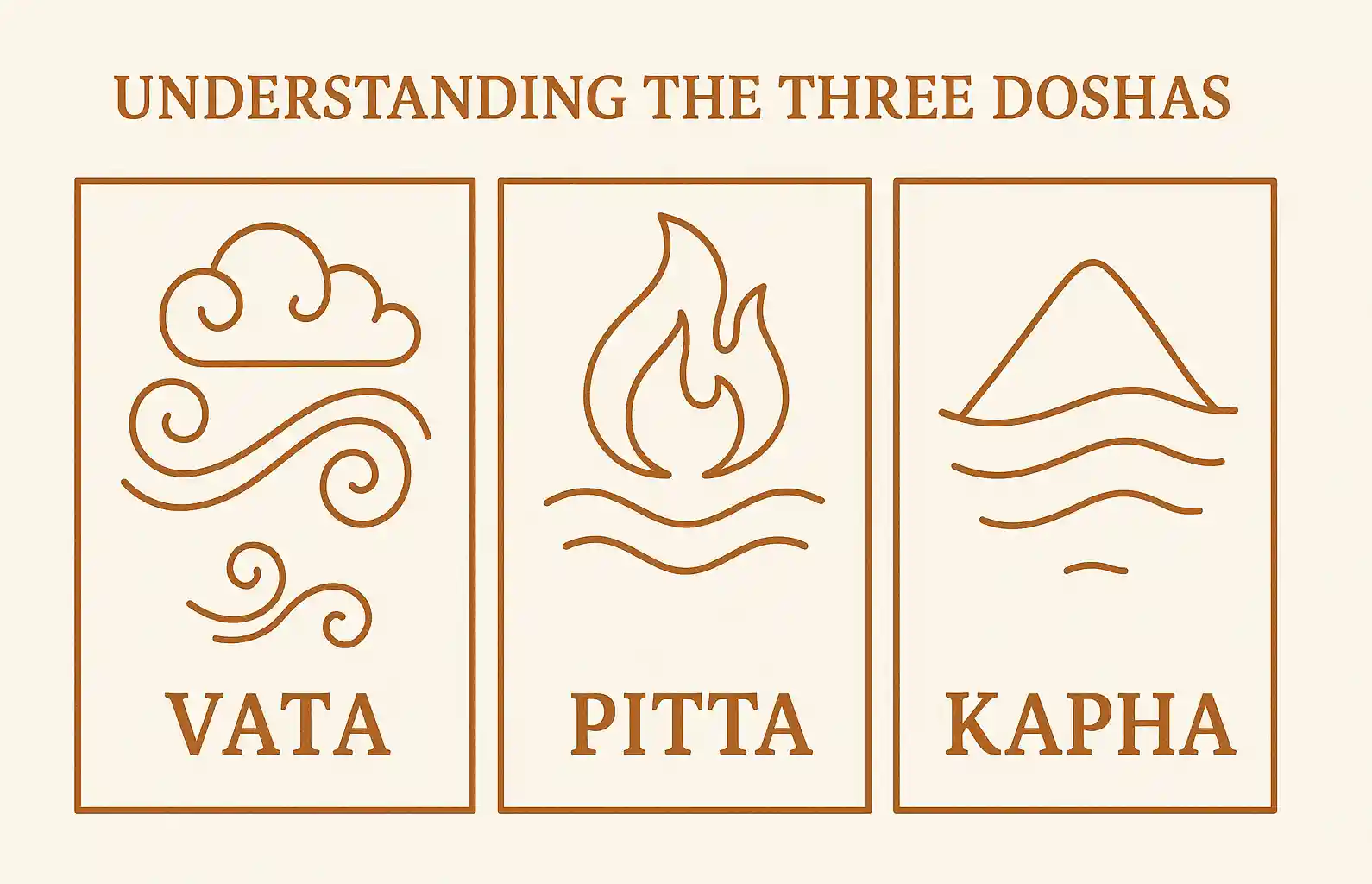In Ayurveda, Vata Dosha is composed of the elements air and ether (space). It is the energy of movement, responsible for biological functions related to motion such as breathing, blood circulation, nerve impulses, and travel. Often referred to as the "king of the doshas," Vata governs the other two doshas—Pitta and Kapha—when in balance, but can also lead to rapid deterioration when out of balance.
Vata is naturally cold, dry, light, mobile, irregular, and subtle. These qualities show up in both the body and mind. Vata-dominant individuals tend to be slim, energetic, and mentally quick but are prone to anxiety, dryness, and instability. When balanced, Vata fuels creativity, joy, adaptability, and vitality.
Key Characteristics of Vata Dosha
Mental Traits of Vata
- Imaginative, intuitive, and mentally agile
- Fast learners but may also forget quickly
- Prone to worry, nervousness, and fear - learn natural approaches to calm anxiety
- Emotionally sensitive and easily stimulated
Physical Traits of Vata
- Thin frame, low body mass, may have difficulty gaining weight
- Dry skin, cracking joints, brittle nails and hair
- Cold extremities, variable energy and endurance
- Irregular appetite and digestion, often with gas or bloating (avoid Vata-aggravating foods that worsen these symptoms)
- Restless sleep, tendency toward insomnia

Vata characteristics - light, mobile, creative energy with tendency toward dryness and irregularity
Common Signs of Vata Imbalance
An imbalanced Vata manifests through various physical, emotional, and mental symptoms. These include:
Physical Symptoms
- Constipation, gas, and irregular bowel movements
- Dry skin, lips, and hair
- Sleep disturbances, insomnia
- Weight loss or difficulty maintaining weight
- Poor circulation and cold hands and feet
Mental & Emotional Symptoms
- Anxiety, restlessness, and indecision
- Excess worry or fear, overwhelm
- Racing thoughts and mental fatigue
- Difficulty concentrating
- Feeling scattered or ungrounded
What Causes Vata to Go Out of Balance?
Vata becomes aggravated through exposure to its own qualities — cold, dry, light, irregular, and mobile conditions. Common causes include:
- Frequent air travel or excessive movement
- Exposure to cold, windy, or dry weather
- Irregular routines — skipping meals or sleep, overexertion
- Overconsumption of cold, raw, dry, or bitter foods
- High stimulation from screen time, loud environments, multitasking
- Excess talking or overthinking
Preventing imbalance involves creating the opposite qualities—warmth, moisture, stability, nourishment, and stillness.
How to Balance Vata Dosha
Balancing Vata means countering its lightness, dryness, and mobility with grounding, warm, oily, and stabilizing inputs.
| Category | Vata-Increasing (Avoid) | Vata-Balancing (Favor) |
|---|---|---|
| Food Temperature | Cold, frozen, iced foods and drinks | Warm, cooked foods and herbal teas |
| Food Texture | Dry, rough, crispy, crunchy foods | Moist, oily, creamy, well-cooked foods |
| Meal Timing | Irregular eating, skipping meals | Regular meal times, consistent schedule |
| Favorable Tastes | Excessive bitter, pungent, astringent | Sweet, sour, salty tastes |
| Grains | Dry cereals, crackers, rice cakes | Oats, quinoa, basmati rice (well-cooked) |
| Vegetables | Raw vegetables, cabbage, broccoli | Cooked root vegetables, carrots, beets |
| Proteins | Beans (dry), raw nuts | Mung dal, tofu, soaked nuts, warm milk |
| Lifestyle | Excessive travel, overstimulation, irregular sleep | Regular routines, grounding practices, adequate rest |
| Activities | Excessive cardio, intense exercise | Gentle yoga, walking, meditation |
| Environment | Cold, windy, dry conditions | Warm, humid, stable environments |
Grounding Foods for Vata
Choose foods that are:
- Warm — cooked soups, stews, porridges
- Moist and oily — with ghee, sesame oil, or avocado
- Sweet, salty, and sour — the most pacifying tastes for Vata
Best Foods for Vata
- Root vegetables (carrots, beets, sweet potatoes)
- Cooked grains (rice, oats, wheat)
- Dairy (warm milk, yogurt if tolerated)
- Spices: ginger, cumin, cinnamon, cardamom, hing (asafoetida)
- Nuts and seeds (almonds, sesame seeds)
- Warm, herbal teas
Foods to Avoid for Vata
- Raw salads, dry cereals, crackers, puffed grains
- Iced drinks, frozen foods, and caffeine excess
- Bitter/astringent-heavy foods like raw greens and legumes (unless cooked with oil and spices)
- Light, airy foods like popcorn
- Irregular eating patterns
Ideal Daily Routine for Vata
Routine is medicine for Vata. Keep your schedule steady and self-care rich:
- Wake before 6:30 a.m. and sleep by 10 p.m.
- Perform abhyanga (self-massage) with warm sesame oil daily
- Practice gentle yoga or slow walks
- Eat three warm, nourishing meals at consistent times
- Avoid overstimulation — build in quiet time and breaks
- End the day with a warm bath and calming tea (e.g., chamomile)
Lifestyle Tips to Calm Vata
- Dress in warm, layered clothing; favor earth tones
- Use essential oils like vetiver, frankincense, or lavender
- Surround yourself with soft textures, calming sounds
- Engage in grounding hobbies—gardening, pottery, journaling
- Limit screen time, social media, and erratic schedules
- Foster deep, calm relationships and reduce multitasking
Vata Dosha in Different Seasons
Vata naturally increases during fall and early winter, when the external environment is also cold, dry, and mobile. During this time:
- Emphasize nourishment and slowing down
- Increase warm, oily, and protein-rich foods
- Reduce travel and late-night activities
- Incorporate warming teas and grounding herbs like ashwagandha or licorice
This is also a key time to reinforce mental and emotional stability through mindfulness, breathwork (e.g., alternate nostril breathing), and quality sleep.
Frequently Asked Questions
Ready to Discover Your Complete Dosha Profile?
Understanding Vata is just the beginning. Take our comprehensive quiz to learn how all three doshas work together in your unique constitution.
Take Your Dosha QuizFinal Thoughts on Vata Dosha
Vata is the dosha of motion, inspiration, and change. While its energy fuels innovation and expression, it requires intentional grounding and nourishment to stay in balance. Through warm meals, predictable routines, and mindful presence, you can harness the gifts of Vata while avoiding its pitfalls.
Remember that understanding your Vata tendencies is part of a larger picture. Each person has all three doshas in different proportions, and learning to work with your unique constitution is a journey of self-discovery and wellness.
Related Articles

Understanding the Three Doshas: Your Guide to Ayurvedic Constitution
Discover the three vital energies that govern your body and mind. Learn how understanding your unique dosha constitution can transform your approach to food, lifestyle, and daily wellness.
6 min read
What Is Pitta Dosha? Understanding Your Fire & Water Constitution
Discover the transformative energy of Pitta Dosha - the fire and water constitution that governs metabolism, mental sharpness, and leadership qualities. Learn how to balance your inner fire.
12 min read
